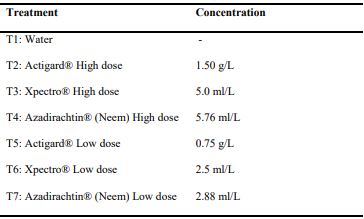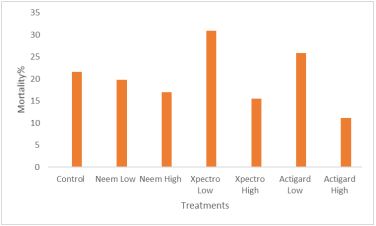Field Testing the Effect of Biopesticides against Wheat Stem Sawfly Management: Dose Response
Principal Investigator: Gadi V.P. Reddy
Project Personnel: Anamika Sharma, Rama Devi Gadi, John H. Miller and Julie Prewitt Western Triangle Agricultural Research Center, Montana State University, 9546 Old Shelby Rd., P.O. Box 656, Conrad, MT 59425, USA
Aim of the Study
The aim of this study was: 1) to determine the effects of three biopesticides (Actigard, Xpectro and Neem) treatment application on wheat stem sawfly (WSS) management, using two doses (low and high concentration) of each product.
Materials and Methods
Locations of winter wheat fields used in field trials.
The field experiments were performed at two locations: Knees (N 48°00'08.5 W 111°21'51.8) and Choteau (N 47°59'36.0 W 112°06'49.9), in the Golden Triangle, Montana, USA. Both experimental locations had moderate to high WSS infestations for several years. The experimental plots were seeded in September 2018 at a rate of 194 live seeds per m2. The seeds were planted in four rows, with 30 cm between rows. Glyphosate (Roundup Powermax®) was applied at the rate of 2.5 L/ ha (the active ingredient of 540 g/L of acid glyphosate) prior seeding to control weed growth. Fertilizers N, P, and K at 224.2, 0, and 22.4 kg/ha were broadcasted while planting, and an additional application of 12.3, 25.2, and 0 kg/ha of these three nutrients were applied through the seed plot drill.
At each field location, treatments were arranged in a randomized complete block design (RCBD) with nine replicates per treatment. Plots for treatments were 3.6 × 1.2 m separated by 0.60 m buffer zones to avoid cross contamination of treatments.
Monitoring of wheat stem sawfly adults
Considering the ideal application time for biopesticides can be one of the important factors for WSS management. Currently, there is no established degree-day model for determining the precise timing of adult emergence. Two methods were used for monitoring the emergence of adults: 1) dissection of WSS-infested stubble to determine the stage of immature development and 2) sweep net sampling in the winter wheat fields to detect adults. Experimental plots and their adjacent winter wheat fields were scouted weekly from the last week of April – first week of June, 2019.
Application of chemicals
From 2017, WSS lab and field trials, we found that two-time application of two biopesticide products (Actigard and Neem) had some impacts on WSS management (Shrestha et al., 2018). In addition, 2016 WSS field trial study showed that two-time application of Xpectro biopesticide product had also some impact especially WSS larval mortality. The two-time applications refer to applications of chemicals when WSS eggs and larvae are expected to be present, respectively, inside stems. Therefore, these three chemicals were used for the study (Table 1). Since these chemicals are relatively expensive than synthetic insecticides, it is important to test whether the repeated lower doses of potential biopesticide product may work for WSS management and thereby reducing costs for winter wheat producers.
The rate of each chemical is presented in Table 1. These treatments were applied in 2018 and in 2019 they were tested again. Treatment application were based on sawfly adult’s emergence timing. First application were done on June 11 (Knees and Choteau locations) 2019. The second application was made on June 17 (Knees and Choteau locations) 2019. Treatments were applied using a SOLO backpack sprayer (SOLO, Newport News, VA) calibrated to deliver about 400 L of spray solution/ha based on nozzle flow and walking speed. Plants treated with water served as untreated control plots. At all field trial locations, chemicals were applied at the wheat stage with 4-6 nodes.
Table 1. Biopesticide products and rate of application in each treatment
Collection of wheat stems
Wheat stems were sampled in all plots to determine the treatment effects during the growing season. Sampling was conducted 3 days before to treatment application (PT), and 10 and 50 days after treatments. Three random samples were collected from two central rows of each treatment plot, with five stems/sample. Wheat stems were cut from the base of plants with help of scissors, placed into one zipper-lock bag, and kept in picnic cooler. During the final sampling time, however, clumps of stems were pulled randomly from three sampling points of two middle rows of each plot with the help of shovel to collect entire matured plants. This technique was used mainly because the WSS diapausing larvae usually prefer to remain at the base of the wheat stem.
Samples were brought to the laboratory, where stems were dissected lengthwise with a fine bladed scalpel to determine the following parameters: 1) WSS stem infestation level; the presence of WSS immatures, parasitoid immature or frass inside dissected wheat stems, 2) WSS immatures population; the presence of eggs and larvae inside dissected wheat stems at each sampling time, 3) WSS larval mortality; the presence of dead larvae inside dissected wheat stems, 4) WSS larval body weight; body weight of diapausing larvae and 5) parasitism rate; presence of parasitoid cocoons inside stems parasitoid holes in stems.
Host and parasitoid adult populations: WSS and Bracon spp.
Three biopesticide products were also tested to examine whether they can repel WSS adults and their impact on WSS parasitoid adult population levels. A sweep net was used to assess insect population (WSS and parasitoid adults). Sweeping was done with a standard sweep net (180o arc), collecting 15 sweeps from each treatment plot. Sampling was done one to two days before treatment application (PT) and, 10, 20 and 30 days after treatment application. Samples were stored in a freezer until examined in the laboratory and insects counted.
Stem lodging level at harvest
WSS larval feeding inside stems caused wheat stands fall into ground and thereby cause difficulty during harvesting. We examined that whether tested chemicals had any effects on plant stand levels during the wheat grain harvest. Wheat stems lodging measurements were made by visual classification rating scale of 1 to 10. The rating of 1 indicates that all plants in a plot were vertical and 10 for all plants in a plot were horizontal.
Yield and quality
To harvest the wheat grains from treatment plots, Hege 140 plot combine was used. The precaution was used to minimize the borders and any overlap of treatment effects on wheat yield and quality. Each plot length was measured, and the wheat grain threshed from each plot. Wheat grains were cleaned with a seed processor (Almaco, Nevada, IA) and weighed on a scale to determine yield. Test weight was measured on a Seedburo test weight scale. The protein and moisture percentages of seed were determined with NIR grain analyzer IM 9500 (Perten Instruments, Springfield, IL).
Statistical analysis
Analysis of variance (ANOVA) was carried out using the PROC Mixed procedure in SAS 9.4 (PROC Mixed, SAS Institute 2018). Data were pooled for each replicate, and treatments were considered as fixed effects while the block was considered a random effect. Normality of data was tested with a Univariate procedure (PROC Mixed). Estimates of least square means and differences of least square means were evaluated (Type 3 test of fixed effects F-test). Multiple comparisons among the treatments were made using Fisher’s Least Significant Test (LSD) at α = 0.05 by using the standard error generated in ANOVA.
Results
WSS infestation level
WSS infestation levels at different sampling time are presented at Table 2. This study showed that treatments had no significant impacts on WSS infestation levels (see Table 2 for statistical output). Overall, there was high variation in infestation levels at different time of sampling. However, Actigard high treatments had numerically lower infestation levels at both the sites compared with untreated control at 10 days after the treatments application, irrespective of location (Table 2).
Table 2. Effects of Neem, Xpectro and Actigard applications on wheat stem sawfly (WSS) infested stem % level (PT and 50 days), yield, and lodging (mean ± SE) in winter wheat fields at the two study location of Montana.
|
|
Knees |
Choteau |
||||||
|
|
Yield |
PT |
50 DAT |
Lodging |
Yield |
PT |
50 |
Lodging |
|
Control |
3788±160a |
20.8±8abc |
98.3±7a |
8.9±1.3a |
4896±132a |
13±3.8ab |
102±6.4a |
5.4±0.6a |
|
Neem Low |
3800±160a |
29±8abc |
101±7a |
9.3±1.3a |
4781±132a |
12±3.8abc |
110±6.4a |
5.5±0.6a |
|
Neem High |
3722±160a |
37±8ab |
100±7a |
6.8±1.3ab |
4582±132a |
8±3.8c |
107±6.4a |
6.3±0.6a |
|
Xpectro Low |
3974±160a |
39±8a |
95.6±7a |
6.4±1.3ab |
4719±132a |
10±3.8abc |
107±6.4a |
6.5±0.6a |
|
Xpectro High |
3744±160a |
15±8c |
100±7a |
6.6±1.3ab |
4741±132a |
8.7±3.8bc |
107±6.4a |
6.6±0.6a |
|
Actigard Low |
3560±160a |
16.7±8bc |
93±7a |
6.8±1.3ab |
4157±132b |
9±3.8bc |
110±6.4a |
5.7±0.6a |
|
Actigard High |
3632±160a |
12±8c |
100±7.9a |
5.4±1.3b |
4010±132b |
14±3.8a |
93±6.4a |
5.6±0.6a |
|
|
437 (0.61) |
21 (0.09) |
20 (0.97) |
3 (0.16) |
335 (<.0001) |
4.8 (0.83) |
17.9 (0.46) |
1.5 (0.52) |
PT, Pre Treatment; DAT, Days After Treatment Application
Wheat stem sawfly adults, and parasitoid adults and their parasitism level
In general, WSS adult populations were found higher at the Knees location compared with Choteau location. Regardless of location, treatments did not have a significant impact on WSS adult population, at any sampling time. Parasitism level was also not found significant however at Knees site Neem low had greater parasitoids population whereas at Choteau site Neem low and high, Xpectro high and Actigard high had greater parasitism levels.
WSS diapausing larval mortality
At Knees site not many diapausing larvae were found. At Choteau site Xpectro low and Actigard low showed numerically higher larval mortality (Figure 1).
Body weight of diapausing WSS larvae
Higher body weight of diapausing larvae were generally found at the Choteau site compared to Knees site (Figure 2). At Choteau site Neem low, Xpectro high and Actigard high showed greater larval weights.
Figure 1: Mortality percentage at Choteau site in 2019.
Figure 2: Larval body weight of diapausing WSS larvae at 50 DAT at Knees and Choteau
locations in 2019.
Wheat stem lodging
No significant variation was found in lodging at both the sites Choteau (df = 48;
F = 1.5; P = 0.5)
and Devon (df = 24; F = 3; P = 0.16). However at Choteau site Neem low had less lodging
whereas
at Choteau site Actigard high had significant less lodging (Table 2).
Yield
In overall, higher average winter wheat yield was found in Choteau. At Knees site
treatments had
no significant impacts on winter wheat grain yield. At the Choteau site Actigard low
and high both
had significantly less yields compared to the other treatments (Table 2).
Acknowledgements
This work was supported by Montana Wheat and Barley Committee.
References
Shrestha, G, Briar, S.S., Reddy, G.V.R., 2018. Plant defense elicitors: Plant fitness
versus wheat
stem sawfly. PeerJ, DOI 10.7717/peer.5892.
SAS Institute Inc. 2018. 9.4 In-Database Products, User’s Guide, fifth ed. SAS Publishers,
Cary,
NC, USA.



